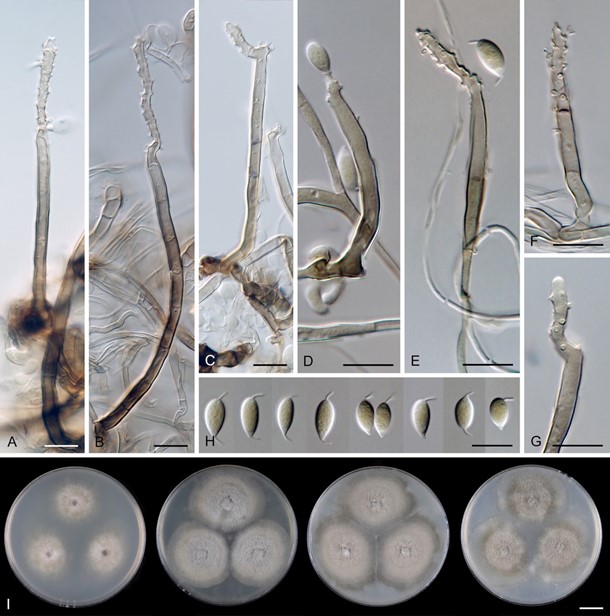Nimesporella capillacea Réblová & Hern.-Restr., sp. nov.
MycoBank number: MB 842212; Index Fungorum number: IF 842212; Facesoffungi number: FoF; (Figure 32).
Etymology: Capillus (L) hair or thread, –acea (L) indicating resemblance, meaning hair-like or thread-like, referring to conidial setulae.
Typification: IVORY COAST, Tai National Park, leaf litter, 11 March 1992, S. Pagano (holotype IMI 358908 microscopic slides, ex-type culture IMI 358908).
Culture characteristics: On CMD: colonies 41–42 mm diam, circular, flat, margin fimbriate, sparsely lanose becoming cobwebby, white, beige toward the periphery, reverse grey-beige, isabelline at the margin. On MLA: colonies 38–39 mm diam, circular, convex, margin entire, lanose, floccose, furrowed, cobwebby at the margin, whitish centrally, beige- grey to ochre-beige with an olivaceous beige outer zone, reverse dark amber. On OA: colonies 65–68 mm diam, circular, flat, margin entire to weakly fimbriate, velvety-lanose, floccose to funiculose centrally, mucoid at the margin, beige with an olivaceous outer zone, reverse olivaceous beige. On PCA: colonies 51–52 mm diam, flat, circular, flat, similar to colonies on OA, sparsely lanose, floccose to funiculose centrally, whitish-beige becoming olivaceous beige, with an isabelline outer zone of submerged growth, reverse zonate, olivaceous beige. Sporulation was abundant on MLA, OA, PCA, sparse on CMD.
Colonies on MLA effuse, mycelium composed of branched, septate, hyaline hyphae 1.5–2.5 µm diam. Anamorph. Setae absent. Conidiophores 28–130 µm long, 3–4.5 µm wide near the base, macronematous, occasionally reduced to conidiogenous cells, grow solitarily from vegetative hyphae or arise in groups of 2–3 from dark knots of hyphal cells, erect, straight or slightly bent, septate, smooth, brown, paler toward the tip. Coni- diogenous cells 22–35(–45) × 3–3.5 µm, slightly tapering upwards, 2–3.5 µm wide below the fertile apical part, integrated, terminal, extending sympodially over a short distance, polyphialidic with 5–22 lateral openings, fertile part 5.5–17(–23.5) × 2–3.5 µm, occasionally dichotomously branched, with persistent remnants of the collarettes; collarettes 1.5–2 µm wide, 1.5–2 µm deep, hyaline, minute, tubular, apically flared, evanescent, the apical part sometimes attached to the bottom of the conidium. Conidia 8–11.5 µm × 4.5–5 µm (mean ± SD = 9.5 ± 0.9 × 4.5 ± 0.2 µm), ellipsoidal, broadly rounded at the apical end, papillate or beak-like at the basal end, aseptate, hyaline, with a straight or gently curved setula at each end, 2–3.5 µm long, positioned terminally at the apex and subterminally at the base, conidia accumulate in slimy whitish fascicles. Teleomorph. Unknown.
Habitat and geographical distribution: Saprobe on leaf litter in freshwater habitat, known in Ivory Coast.
Notes: Nimesporella capillacea closely resembles N. aliformis, N. daphnioides and N. tumi- dospora, all known only from Malaysia [22], but which differ in having longer conidiophores and larger conidia.

Figure 32. Nimesporella capillacea (IMI 358908 ex-type). (A–G) Conidiophores (H) conidia (I) colonies on CMD, MLA, OA and PCA after 4 week (from left to right). Images: (A–H) on PCA after 4–6 weeks. Scale bars: (A–H) 10 µm; (I) 1 cm.
